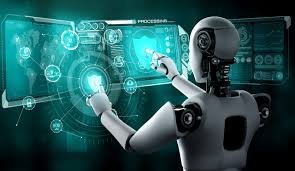
The world of technology is advancing at an unprecedented pace, and among the most transformative innovations of our time are Artificial Intelligence (AI) and Machine Learning (ML). As we look ahead to 2025, the potential for these technologies to reshape industries and improve our daily lives is immense. But what does this future really look like? Let’s break it down.
Understanding AI and Machine Learning
Before diving into the future, let’s take a quick look at the difference between AI and ML:
- Artificial Intelligence (AI): Refers to the simulation of human intelligence in machines designed to think and act like humans. AI systems can learn from data, reason through problems, and even make decisions.
- Machine Learning (ML): A subset of AI, where systems can learn from and adapt to new data without being explicitly programmed. ML enables algorithms to improve over time, becoming smarter as they are exposed to more information.
What’s Driving the Rise of AI & Machine Learning?
The adoption of AI and ML is being propelled by several key factors:
1. Data Explosion
In 2025, the volume of data we generate is expected to continue growing exponentially. From social media interactions and customer behaviors to sensor data from IoT devices, businesses now have more data than ever before. AI and ML thrive on big data, using it to detect patterns, predict outcomes, and optimize processes.
2. Advancements in Computational Power
The continuous advancements in computing technology, especially with quantum computing on the horizon, will significantly boost AI’s capabilities. More powerful processors mean faster data processing, quicker model training, and the ability to tackle more complex problems.
3. Increased Automation
From self-driving cars to smart homes, automation is already beginning to change the way we interact with the world. Machine learning algorithms are at the heart of these systems, enabling devices and services to operate independently and adapt in real-time.
4. More Accessible AI Tools
In 2025, tools for developing and deploying AI models will become even more accessible to businesses of all sizes. Open-source platforms like TensorFlow and PyTorch, along with cloud-based AI services (e.g., AWS AI, Google Cloud AI), will democratize AI, allowing startups and smaller enterprises to harness its power.
How Will AI and Machine Learning Transform Key Industries by 2025?
Let’s explore how AI and ML will impact key industries in the next few years.
1. Healthcare: Revolutionizing Diagnostics and Treatments
AI is poised to revolutionize the healthcare industry by 2025. Machine learning algorithms are already capable of analyzing medical images to detect conditions like cancer at earlier stages than human doctors. In the future, AI will assist in developing personalized treatment plans based on individual genetics, lifestyle, and health data.
Key Developments:
- AI-driven drug discovery
- Predictive analytics for patient care
- Virtual healthcare assistants and chatbots
2. Finance: Smarter Decision Making
The financial industry has been leveraging AI for some time now, but by 2025, machine learning models will become even more sophisticated. Algorithms will not only help detect fraud in real time but also offer personalised financial advice by analysing individual spending habits and goals.
Key Developments:
- AI-powered fraud detection
- Automated trading systems
- Personalised investment advice
3. Manufacturing: Efficiency and Predictive Maintenance
Machine learning algorithms will be crucial in optimising supply chains, inventory management, and production processes. In manufacturing, AI will help predict when machinery needs maintenance before it breaks down, reducing downtime and improving productivity.
Key Developments:
- Predictive maintenance using AI
- Automation of repetitive tasks
- AI in quality control and defect detection
4. Retail: Hyper-Personalisation
By 2025, the retail industry will be heavily reliant on AI and ML for hyper-personalised customer experiences. From personalised recommendations based on previous purchases to automated inventory management, AI will make shopping more seamless for consumers.
Key Developments:
- AI-driven product recommendations
- Chatbots for customer support
- Dynamic pricing and inventory management systems
5. Autonomous Vehicles: The Road to Self-Driving Cars
While self-driving cars are already in development, by 2025, we expect to see wider adoption of autonomous vehicles on the roads. AI and ML algorithms will power navigation, decision-making, and traffic management systems to ensure safety and efficiency.
Key Developments:
- Fully autonomous vehicles
- AI-driven traffic management systems
- Real-time hazard detection
Ethical Considerations and Challenges
As AI and ML continue to rise, they bring about important ethical challenges that we must address:
- Bias in AI Algorithms: Machine learning models are only as good as the data they are trained on. If the data is biased, the AI can perpetuate and even amplify these biases. Ensuring that AI is fair and unbiased is a key challenge moving into 2025.
- Job Displacement: As automation increases, there will be concerns about job displacement, particularly in roles that are repetitive or manual. However, AI also has the potential to create new jobs, particularly in data science and AI ethics.
- Privacy Concerns: With AI analyzing vast amounts of personal data, ensuring the privacy and security of individuals is more important than ever. Stricter data protection regulations will be needed to protect consumers from misuse of their data.
What to Expect in the Future: 2025 and Beyond
Looking ahead, AI and machine learning will continue to evolve at a rapid pace. By 2025, we can expect more intelligent systems, autonomous devices, and predictive analytics that will seamlessly integrate into our lives, making both personal and professional experiences more efficient and enjoyable.
But as with all technological advancements, it’s crucial to balance innovation with responsibility. We must prioritize ethical AI development, data privacy, and inclusive AI training to ensure that AI’s benefits are accessible to all.
